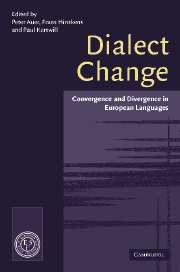Book contents
- Frontmatter
- Contents
- List of maps
- List of figures
- List of contributors
- Preface
- Map
- 1 The study of dialect convergence and divergence: conceptual and methodological considerations
- Part 1 Convergence, Divergence and Linguistic Structure
- 2 Internal and external factors in phonological convergence: the case of English /t/ lenition
- 3 Dialect/standard convergence, mixing, and models of language contact: the case of Italy
- 4 Convergence and divergence in grammar
- 5 Phonology, grammar, and discourse in dialect convergence
- Part 2 Macrosociolinguistic Motivations of Convergence and Divergence
- Part 3 Microsociolinguistic Motivations
- References
- Index
5 - Phonology, grammar, and discourse in dialect convergence
Published online by Cambridge University Press: 22 September 2009
- Frontmatter
- Contents
- List of maps
- List of figures
- List of contributors
- Preface
- Map
- 1 The study of dialect convergence and divergence: conceptual and methodological considerations
- Part 1 Convergence, Divergence and Linguistic Structure
- 2 Internal and external factors in phonological convergence: the case of English /t/ lenition
- 3 Dialect/standard convergence, mixing, and models of language contact: the case of Italy
- 4 Convergence and divergence in grammar
- 5 Phonology, grammar, and discourse in dialect convergence
- Part 2 Macrosociolinguistic Motivations of Convergence and Divergence
- Part 3 Microsociolinguistic Motivations
- References
- Index
Summary
Introduction
The phenomenon of dialect convergence presents us with an opportunity to examine an issue that is not yet well understood in variation studies: the extent to which linguistic variation in different components of language patterns in similar ways. There have been more studies of phonetic and phonological variation than of any other kind, with the result that we now know a great deal about how sound changes typically spread through a speech community. Studies of morphosyntactic variation have been gently increasing in number, but sociolinguistic analyses of variation in discourse and, especially, in syntax remain relatively scarce. We still do not know, therefore, whether generalisations concerning the spread of sound change apply equally well to other types of language change, nor whether stable linguistic variation in phonology, grammar, and discourse features has a similar sociolinguistic distribution within a community.
The study of dialect convergence might shed light on these questions because the expectation here is, precisely, that there should be considerable commonality in the direction of change and, perhaps, in the rate of change also. If regionally or socially marked phonological features are being levelled within a community, we might expect other regionally or socially marked features to be levelled as well, with perhaps the same speakers or the same social groups driving all types of change.
- Type
- Chapter
- Information
- Dialect ChangeConvergence and Divergence in European Languages, pp. 135 - 168Publisher: Cambridge University PressPrint publication year: 2005
- 23
- Cited by



